As an Amazon Associate I earn from qualifying purchases.
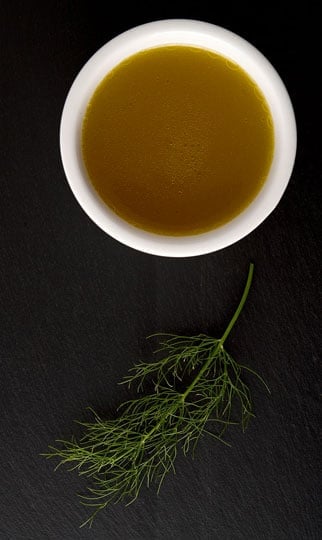
I catch a lot of striped bass, and while I love to eat the fillets, I am always more excited about the heads and bones because they make a surpassing fish stock. And to me, fish stock is one of those zephyrs of the food world, a mystical wonderment that lasts only as long as it takes to make and eat it.
Yes, you can store fish stock, and it’s OK, but never as amazing as when it has been freshly made.
So that means I normally find myself making fish risotto or chowder right off the bat when I have a good haul of stripers, Pacific rockfish or lingcod. The fillets get eaten later. Yes, I am aware this is opposite to what most people do. Pretty typical for me.
Fish stock isn’t like normal stock. It’s a fairly quick affair. My venison stock takes all day, or even overnight. All my fish stock asks of you is 45 minutes or so. Strain and enjoy. A long-simmered fish stock gets cloudy and bitter and fishy. I don’t recommend it.
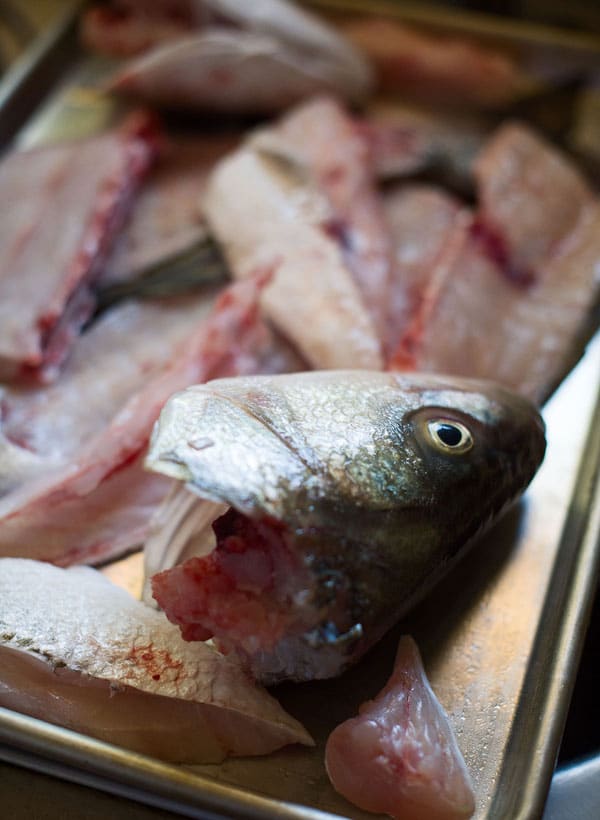
What fish? Really almost anything. I’ve made fish stock with bass, walleye, perch, black seabass, white seabass, lingcod, Pacific rock cod, stripers, tilefish, porgies, redfish, sea trout, spotted bass, bluegills… you get the point.
Be sure to rinse the heads and bones well to remove slime, and be absolutely certain to snip our the gills. Gills in your stock will ruin it, as the blood in them will cloud your stock and give it an “off” flavor very quickly.
Homemade Fish Stock
Ingredients
- 3 tablespoons olive oil
- 1 large onion, chopped
- 1 large carrot, chopped
- 1 fennel bulb, chopped (optional)
- 3 celery stalks, chopped
- Salt
- 2 cups white wine or vermouth
- 2 to 5 pounds of fish bones and heads
- A handful of dried mushrooms (optional)
- 2 to 4 bay leaves
- 1 star anise pod (optional)
- 1 to 2 teaspoons dried or fresh thyme
- 3 or 4 pieces of dried kombu kelp (optional)
- Chopped fronds from the fennel bulb
Instructions
- Heat the olive oil in a large stockpot over medium-high heat. When the oil is hot, add the chopped vegetables and cook, stirring often, until they are all soft, but not browned. This should take about 10 minutes or so.
- Add the white wine and all the remaining ingredients, plus enough water to cover everything by about an inch or two. Bring to a simmer, then drop the heat to a bare shimmy, about 175°F if you want to be precise. It should not boil under any circumstances, and keep an eye on things to ensure that it doesn't. Simmer like this for 45 minutes to 1 hour, no more.
- Turn the heat as low as it will go. Set a fine mesh strainer over a big bowl, then put a piece of paper towel or cheesecloth in the strainer. Ladle the stock through this set-up into the bowl. When you get to the bottom, skip the dregs down there, as they will be filled with sediment. The stock will never be as good as it is right now, but it can be refrigerated for up to a week and frozen for up to 6 months.
Video
Notes
Nutrition
Nutrition information is automatically calculated, so should only be used as an approximation.
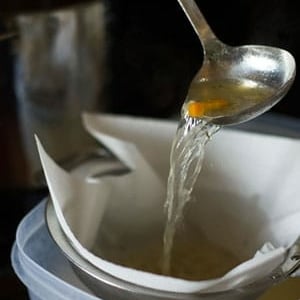
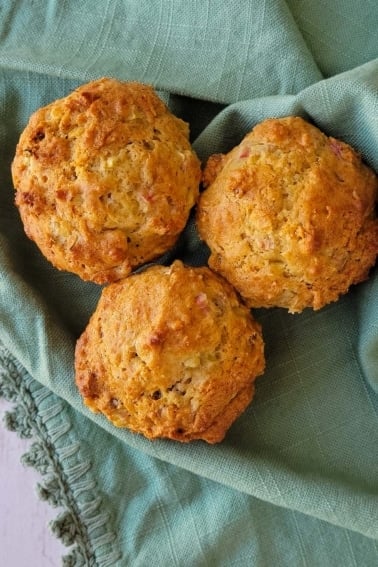

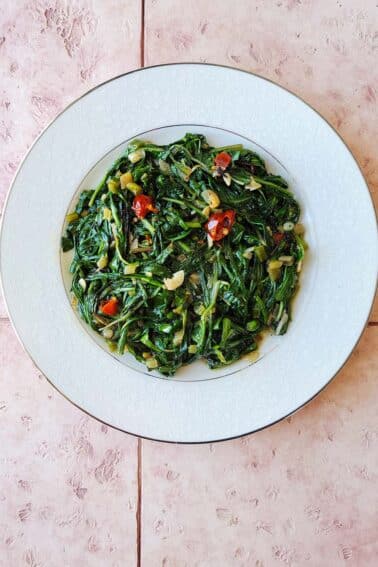
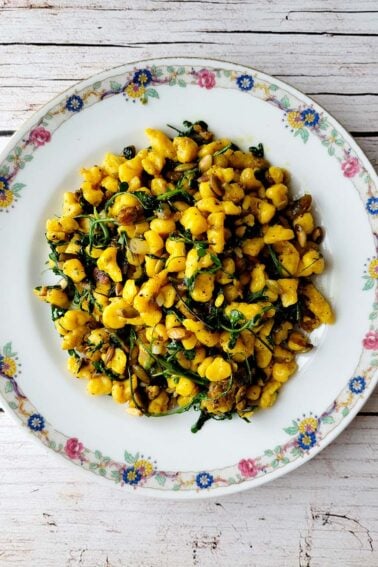
What about the bloodline? I always trim it out and either use it in my garden as fertilizer or throw it back into the water to feed the crawfish. If I’ve gone to the trouble of bringing it home it would be nice to have an edible use for it, but the fishy flavor is pretty strong. Any recommendations?
Grayson: I leave it in. If the fish is very fresh, it’s not a problem. Besides, you generally make fish stock from lean, white fish, which have a pretty narrow bloodline. I would not make stock from a fish with a big one, like shad or mackerel or tuna. And if I had to, I would remove the bloodline.
The fragrance of the stock was amazing and it was used to make a seafood bisque. Clam chowder will be next. I used Alaskan sockeye salmon tails.
Awesome fish stock, Hank! Used fresh fish from the Cancun market (caught in the morning, fresh as can be) added some fresh blue crabs. So fresh it did not even smell like fish! Made sure it didn’t come to a boil. Strained it 3 times using cheesecloth. The color was still murky.
That’s okay for a cream soup or chowder. But as a perfectionist, I opted to make a consomme using the egg white raft. Wow! It worked perfectly. Clear as a bell. Beautiful amber color. Reducing it slowly now to 50%.
So thrilled with the results. Thank you for such a simple yet potent fish stock recipe. Always been afraid to try it. Not anymore.
Making fish stock helps me feel like I get more mileage out of the small bluegill and perch I catch out of the local ponds (beyond their delicious and tiny filets). I’ve been more than pleased with the results from following this recipe.
Hank, two questions. 1) Catfish? 2) Can you freeze the bones and heads then make stock later?
You’re one of only two go-to sites for us for wild game recipes. Love ya!
Judy: Yes and yes. I do prefer less fatty fish, but catfish will work.
Could I skip the kelp and the fennel?? What can I use for a substitute??
Joann: Yep, you can skip them. No need for a substitute, but if you wanted to, one or two star anise pods, or a tablespoon of anise seeds would do.
I’m a reasonable ‘chef’, (in my 60s) I have always thought: Meat stock 10 hours plus; Fish stock 10 mins. Am I wrong? Does fish stock improve cooked around 45 mins?
Kevin: Yes, that is too short a time for fish stock. You will normally see anything from 30 minutes to an hour.
How big is the stockpot? How much water should I be topping it off with?
Andrea: It’s big, but that doesn’t really matter. Cover your ingredients by no more than about an inch or so, as this is not a long simmered stock.
This is truly delicious. It is amazing how much more fishy the stock is if you make the mistake of letting it boil. Two questions though. First, can you reduce the stock to thicken it by continuing to simmer it after removing the solids, or could you even boil it then? And two, how do you ensure killing off any bacteria left over from the cleaning process (even after thorough rinses) if the stock never boils?
Nick: Don’t reduce it. It gets fishy. And bacteria etc all die at 140F, which is well below the simmer.
Wow! That is the best fish stock I’ve ever tried. This recipe is a keeper.
How is smoked fish in a broth for chowder?
Mary Jane: I like using smoked fish in chowder.
Thanks Hank, caught a beautiful bass in the English Channel last night and this recipe is perfect for the bones. I’m waiting not very patiently to try it!
Can this recipe be preserved with a pressure canner?
Juliette: yes it can.
Hank! Lovely recipe! I used Chinook salmon and I love the flavor profile! Delicious! Thank you for an awesome website for me to add to my reference library!
where do i find a mesh bag to cook the heads and bones in
Sandy: Who knows? I never use one.
I improvised. We made herb crusted Ahi the other night, and refused to let my husband clean the pan. Too much good fond in the pan. I used it as my base for the veggies. I didn’t have seaweed on hand and didn’t feel like snorkeling to get some. Oh, and I used wild caught lump fish instead of heads and such. Turned out delicious, and you can bet .I’ll be making seafood chowder this weekend ! Nancy
Hank,
Would you include the skins and fins?
Or just stick to bones and heads?
Is it ok if there’s some meat clinging to the bones?
Tom: Yes on all counts. Skin and fins add some collagen to the stock. And yes, it’s good to have a little meat on those bones!
Definitely a great staple. Thanks for sharing!
Very interesting Hank! When browsing my local used bookstore, I judge a seafood cookbook by its recipes for seafood chowder and fish stock, which had better be an ingredient in the chowder! But your recipe is definitely NOT what I typically expect to see. Make miso much? Glad to see you warn against the boil 😉 The fennel surprised me the most, though also the absence of black peppercorns. But judging from your other recipes, this is going to have to be made and tried (though with free head-on flounder bones from my local fishmonger). Thanks for sharing!
-Pete
Hank,
You just explained why my salmon stock turned out the way it did. Oh well.. live and learn.
(it was still edible)
Hank,
I’ve been really loving how good fish (and vegetable) stock comes out cooked sous vide packed in a FoodSaver bag. Have you tried this method? The stock comes out highly flavorful, clear and clean.
Question, many claim that the eyes need to be removed from fish as well before making stock.I have been doing that but really hate doing it. I’m thinking you do not think this is something I should worry about. Right?
Elie: Never removed the eyes ever. It’s not a problem.